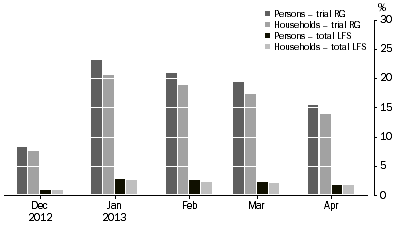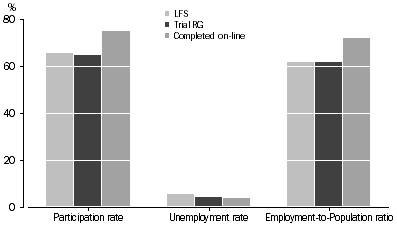TRANSITION TO ONLINE COLLECTION OF THE LABOUR FORCE SURVEY
INTRODUCTION
This article describes how a change in data collection method will be implemented in the ABS's Labour Force Survey (LFS) and the strategy that has been designed to measure the impact, if there is any, on the key statistical series.
As advised in previous issues of this publication, a trial of online self-completion of labour force data from households has been undertaken since December 2012. This trial has been conducted on one rotation group (i.e. one-eighth of the survey sample) and these respondents have been offered the option of self-completing the survey online in place of a face-to-face or telephone interview.
The ABS will expand the offer of online self-completion to all households selected in the LFS, commencing with each new incoming rotation group from May 2013.
ROLL-OUT SCHEDULE
The expansion of the offer of online self-completion in the LFS will coincide with the roll-out of the new Monthly Population Survey sample. The new sample, based on the 2011 Census of Population and Housing, will be introduced over four months - May 2013 to August 2013. Two rotation groups (i.e. one-quarter of the survey sample) will be introduced each month in order to minimise any impact on the key estimates of implementing the new sample. More detail on the new sample will be released on 30 May in the Information Paper: Labour Force Survey Sample Design, May 2013 (cat. no. 6269.0). An overview is available in the July 2012 issue of this publication.
To enable comparisons of those offered the survey online and those who were not, online self-completion will initially be offered to 50% of each incoming rotation group. These offers will be in addition to the existing rotation group included in the initial trial. The proportion of the LFS sample offered online self-completion will increase by 12.5% each month for the first three months. See the table below for more information.
As outlined in the next section, the ABS will use information collected in the LFS to gain an understanding of any potential impacts on the key labour force estimates resulting from the introduction of online self-completion. Subject to the findings of these analyses, the ABS intends to progressively increase the offer to 100% of each incoming rotation group from September 2013. In the long term, it is proposed that online self-completion will become the primary form of collecting LFS data. Interviewer collection (both face-to-face and via telephone) will continue to be available for those respondents where it is inappropriate for operational, technological or personal reasons.
Planned online electronic collection offer, Labour Force Survey - April 2013 to September 2013 |
|
 | Rotation groups offered | Proportion of rotation group/s offered | Proportion of LFS sample offered |
|
| April | (a)Trial RG | 100% | 12.5% |
| May | Trial RG + 2 incoming RGs | 100% trial RG + 50% x 2 RGs | 25.0% |
| June | Trial RG, 2 existing + 2 incoming RGs | 100% trial RG + 50% x 4 RGs | 37.5% |
| July | Trial RG + 4 existing + 2 incoming RGs | 100% trial RG + 50% x 6 RGs | 50.0% |
| Aug(b) | 6 existing + 2 incoming RGs | 50% x 8 RGs | 50.0% |
| Sept | All eight RGs | 50% x 7 RGs and 100% x 1 RG | 56.25% |
|
| (a) RG = rotation group |
| (b) The trial rotation group will rotate out of the LFS after eight months in the LFS. |
While the offer of online self-completion will gradually increase to 100% of the LFS, the ABS estimates that initially the completion of LFS online will only be around 10%-20% of those respondents who are offered the option. Over time this figure should increase.
MEASUREMENT STRATEGY
The ABS is using its experience developed in introducing previous changes to the LFS and other statistical collections to minimise any potential impact of the transition to online collection. This includes trialing the online collection on one rotation group, progressively rolling out the full implementation and having a strategy to measure any significant impacts on the estimates.
While the ABS expects the impacts of online collection to be minimal, the ABS will monitor any impact of the move from interviewer collection to online self-completion electronic collection through a measurement strategy. This strategy examines two different aspects of the introduction of online collection:
- The presence of a large statistical impact (larger than three standard errors) due to the offer of online collection, if there is one. This will most likely be identified over the first four months of the roll-out period (ie by the release of August estimates in September 2013) but monitoring will continue as the roll-out proceeds. The impact of the offer will need to be large to be detected and will be used to inform on whether to progress to a 100% roll-out of online collection.
- A statistical impact on the estimates due to the self-completion of the survey on-line. Analysis will be conducted on an on-going basis over the next 12 months to identify and quantify if there has been any statistical impact.
Any impacts identified through the measurement strategy will be reported in
Labour Force, Australia (cat. no. 6202.0).
ONLINE ELECTRONIC COLLECTION TAKE UP
Respondents selected in the LFS (other than those selected in the trial rotation group) are sent a letter and brochure informing them that they have been selected and that an interviewer will visit their house to interview their household. The letter advises that they have the option of providing their contact details securely online or ringing the office so an interviewer will visit their house at a time suitable to them. They can also opt to complete the survey over the phone. Respondents in the trial rotation group were provided a third option of self-completing their survey securely online in place of an interview.
The trial rotation group monthly take up rate of the online electronic collection is shown in the graph below. For December 2012, their first month in the survey, the take up rate was about 8% of persons in the trial rotation group, and this increased to 23% in January 2013. These respondents represented 1% of the total LFS sample in December and almost 3% in January. The increase in January was the result of interviewers continuing to offer respondents the option of completing the survey online after their first month. The take up rate has decreased slightly in each subsequent month. This has been the net result of additional households opting to take-up online self-reporting each month while other households have elected to move from online reporting to reporting via an interviewer. The uptake of online LFS completion in April was 15% of the rotation group (2% of the total LFS sample).
Online electronic reporting take-up rates, Labour Force Survey
- Dec 2012-Apr 2013

CHARACTERISTICS OF RESPONDENTS WHO SELF-COMPLETED THE LFS ONLINE
Unsurprisingly, those respondents who chose to complete the LFS online had different characteristics to those who chose to report via face-to-face or telephone interview. Those who chose to complete the survey online had a higher proportion of single family households, and a lower proportion of two-family, group and lone person households. They were also likely to be a two-person household.
Overall they were more likely to be employed than their rotation group as a whole and had a higher labour force participation rate, as seen in the graph below.
Key Labour Force Characteristics, Labour Force Survey
- April 2013

FURTHER INFORMATION
For any queries, contact Labour Force Estimates on Canberra 02 6252 6525, or via email on labourforce@abs.gov.au
 Print Page
Print Page
 Print All
Print All
 Quality Declaration
Quality Declaration